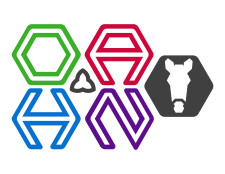OAHN Equine Project: Serum Selenium concentrations in Ontario broodmares and their foals (in progress)

Project Lead: Dr. Luis Arroyo
Collaborators: Dr. Alison Moore
Background and Proposal
Selenium (Se) is a key element involved in multiple metabolic pathways, but more importantly is an essential co-factor of the intracellular enzymes glutathione peroxidases (GPxs). Glutathione peroxidases are part of an enzyme family with peroxidase activity (i.e. break up peroxides) whose main biological roles are to protect against oxidative damage by reducing lipid hydroperoxides and free hydrogen peroxide (Minich W, 2022)
There are several diseases in farm animals associated with Se and vitamin E deficiencies, either in combination or alone. The most common clinical disease in foals associated with Se deficiency is nutritional myo-degeneration which is also known as white muscle disease. There are however several and variable clinical presentations that can range from per-acute to subacute forms of myo-degeneration affecting skeletal and cardiac muscle (Higuchi et al. 1989; Löfstedt, 1997).
Mares deficient in Se during gestation may not transfer enough of this nutrient to the placenta of the developing fetus. Further, Se concentration in mare’s milk is low and therefore generally considered a minor source of this element for foals regardless of Se status of the mares at parturition. Foals that do not receive sufficient Se from their mother during gestation are at risk of developing white muscle disease (Thorson et al., 2010, Quaresma et al., 2021). Further, congenital forms of white muscle disease are reported in foals and other farm animal species (MacQuarrie 2017).
Muscle weakness is reported in a very high proportion (96%) of foals with subacute disease.
Other clinical signs such as dysphagia or a weak suckle reflex due to lingual, pharyngeal, and masticatory muscle involvement is frequently reported in foals with this subacute form of the disease (Löfstedt, 1997).
Of note, many foals admitted to the Ontario Veterinary College-Large Animal Hospital in recent years with clinical signs such as milk dripping from the nose (dysphagia) or unable to nurse, had low serum Se levels. More severely affected foals may present with generalized stiffness, muscle tremors, difficulty standing, or inability to stand.
Se concentrations in soils and ground water are low in many countries and/or regions of the world, and the bioavailability of Se may also be limited in some forages, which can lead to Se deficiency in animals. Muirhead and co-workers reported that the Se status was either marginal or deficient in 79% of horses in Prince Edward Island based on current reference ranges. The more affected groups were aged and young adult pleasure horses (82% and 97%, respectively) but the prevalence of inadequate Se concentrations in broodmares (72%) was also very high (Muirhead et al., 2010). In eastern Canada serum Se deficiency is a well-documented condition in horses and a significant concern in that region (Montgomery et al., 2012). The regions around the Great Lakes in Canada and USA are also known for their Se deficient soil and feedstuff (Source: https://openpress.usask.ca/soilscience/chapter/soils-of-ontario/
The Se content in forage is determined by the Se content of the soil but is also markedly influenced by factors such as the soil pH, phosphate and organic matter content for example, also known as the soil fertility. Forages and grains grown in parts of North America, including Ontario, contain insufficient amounts of Se to meet the dietary requirements of livestock. Therefore, a complete soil fertility analysis of the top soil is recommended every four years in deficient territories (Delesalle et al., 2017). Further it is also recommended to monitor the Se status of broodmares and their herdmates in Se deficient regions (Delesalle et al., 2017).
We hypothesized that Se deficiency is common and underdiagnosed in foals born in southern Ontario. Further, the efficacy of dietary supplementation to broodmares and parenteral administration of Se to neonatal foals to address Se deficiencies have not been periodically investigated.
References
- Minich WB. Selenium Metabolism and Biosynthesis of Selenoproteins in the Human Body. Biochemistry (Mosc). 2022 Jan;87(Suppl 1):S168-S102.
- Thorson JF, Karren BJ, Bauer ML, Cavinder CA, Coverdale JA, Hammer CJ. Effect of selenium supplementation and plane of nutrition on mares and their foals: foaling data. J Anim Sci. 2010 Mar;88(3):982-90.
- Quaresma M, Marín C, Bacellar D, Nóvoa M, Navas FJ, McLean A. Selenium and Vitamin E Concentrations in Miranda Jennies and Foals (Equus asinus) in Northeast Portugal. Animals (Basel). 2021 Jun 14;11(6):1772.
- MacQuarrie J. Congenital nutritional myodegeneration in a neonatal foal. Can Vet J. 2016; 57:781-4.
- Higuchi T. et al. 1989. Studies on serum selenium and tocopherol in white muscle disease of foals. Nihon Juigaku Zasshi. 1989.
- Jeanne Löfstedt, White Muscle Disease of Foals, Veterinary Clinics of North America: Equine Practice, 1997, 13:169-185
Muirhead TL, Wichtel JJ, Stryhn H, McClure JT. The selenium and vitamin E status of horses in Prince Edward Island. Can Vet J. 2010 Sep;51(9):979-85. PMID: 21119864; PMCID: PMC2920172. - Delesalle C, de Bruijn M, Wilmink S, Vandendriessche H, Mol G, Boshuizen B, Plancke L, Grinwis G. White muscle disease in foals: focus on selenium soil content. A case series. BMC Vet Res. 2017 May 3;13(1):121. doi: 10.1186/s12917-017-1040-5. PMID: 28468621; PMCID: PMC5415829.
- Montgomery JB, Wichtel JJ, Wichtel MG, McNiven MA, McClure JT, Markham F, Horohov DW. Effects of selenium source on measures of selenium status and immune function in horses. Can J Vet Res. 2012; 76:281-91.
- Streeter RM, Divers TJ, Mittel L, Korn AE, Wakshlag JJ. Selenium deficiency associations with gender, breed, serum vitamin E and creatine kinase, clinical signs and diagnoses in horses of different age groups: a retrospective examination 1996-2011. Equine Vet J Suppl. 2012 Dec;(43):31-5.

